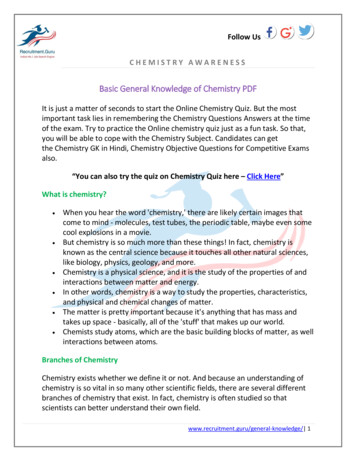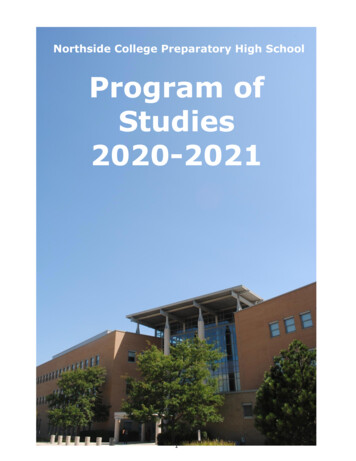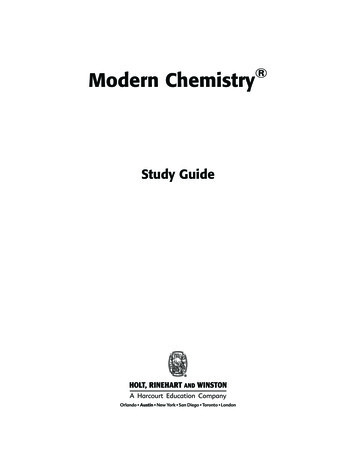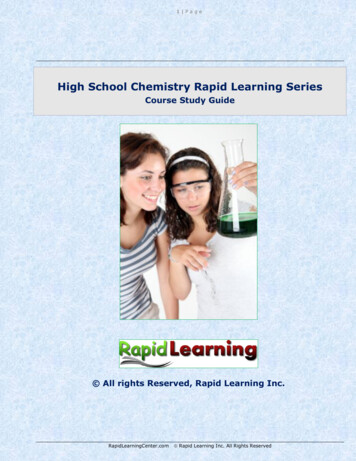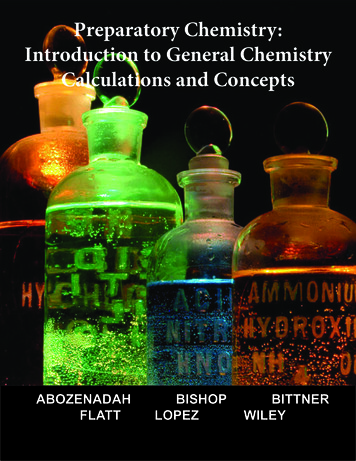
Transcription
Preparatory Chemistry:Introduction to General ChemistryCalculations and ConceptsABOZENADAHFLATTBISHOPLOPEZBITTNERWILEY
Published by Western Oregon University under Creative Commons Licensing asAttribution-NonCommercial-ShareAlike CC BY-NC-SA 3.0 on Dec 15th, 2017To Share or Adapt this Content please Reference:Abozenadah, H., Bishop, A., Bittner, S. Flatt, P.M., Lopez, O., and Wiley, C. (2017) Consumer Chemistry:How Organic Chemistry Impacts Our Lives. CC BY-NC-SA. Available at:Cover photo adapted s/thumb/e/e1/Chemicals in flasks.jpg/675px-Chemicals in flasks.jpgChapter 1 materials have been adapted from the following creative commonsresources unless otherwise noted:1. Anonymous. (2012) Introduction to Chemistry: General, Organic, and Biological (V1.0).Published under Creative Commons by-nc-sa 3.0. Available at: .html2. Poulsen, T. (2010) Introduction to Chemistry. Published under Creative Commons bync-sa 3.0. Available at: http://openedgroup.org/books/Chemistry.pdf3. OpenStax (2015) Atoms, Isotopes, Ions, and Molecules: The Building Blocks. OpenStaxCNX.Available at: 7c25fb2c99@12.
Table of ContentsSection 1: Chemistry and Matter What is Chemistry? Physical vs. Chemical Properties Elements and Compounds Mixtures States of Matter Section 2: How Scientists Study Chemistry The Scientific Method Section 3: Scientific Notation Section 4: Units of Measurement International System of Units and the Metric System Mass Length Temperature Time Amount Derived SI Units Volume Energy Density Section 5: Making Measurements in the Lab Precision vs. Accuracy Significant Figures Exact Numbers Rules of Rounding Calculations with Significant Figures Conversions and the Importance of Units Conversion Factors Section 6: Chapter Summary Section 7: References: Practice Problem Answer Key: Section 2: Section 3: 3031323232
Section 1: Chemistry and MatterWhat is Chemistry?Everything around us is made up of chemicals. From the color that makes a rose sored to the gasoline that fills our cars and the silicon chips that power our computersand cell phones Chemistry is everywhere! Understanding how chemical moleculesform and interact to create complex structures enables us toharness the power of chemistryand use it, just like a toolbox, tocreate many of the modern advances that we see today. Thisincludes advances in medicine,communication, transportation,building infrastructure, food science and agriculture, and nearlyevery other technical field thatyou can imagine.Chemistry is one branch of science. Science is the process bywhich we learn about the naturaluniverse by observing, testing,and then generating models thatFigure 1.1: The Relationships Between Some of the Major Branchesexplain our observations. Beof Science. Chemistry lies more or less in the middle, which emphacause the physical universe issizes its importance to many branches of science.so vast, there are many different branches of science (Figure1.1). Thus, chemistry is the study of matter, biology is the study of living things, andgeology is the study of rocks and the Earth. Mathematics is the language of science,and we will use it to communicate some of the ideas of chemistry.Although we divide science into different fields, there is much overlap among them.For example, some biologists and chemists work in both fields so much that their workis called biochemistry. Similarly, geology and chemistry overlap in the field called geochemistry. Figure 1.1 shows how many of the individual fields of science are related.Physical vs. Chemical PropertiesPart of understanding matter is being able to describe it. One way chemists describematter is to assign different kinds of properties to different categories. The properties4
that chemists use to describe matter fall into two general categories. Physical properties are characteristics that describes matter, such as boiling point, melting point andcolor. Physical Changes, such as melting a solid into a liquid, do not alter the chemical structure of that matter. Chemical properties are characteristics that describe howthe chemical structure of matter changes during a chemical reaction. An example of achemical property is flammability—a materials ability to burn—because burning (alsoknown as combustion) changes the chemical composition of a material.Elements and CompoundsAny sample of matter that has the same physical and chemical properties throughoutthe sample is called a substance. There are two types of substances. A substance thatcannot be broken down into chemically simpler components is an element. Aluminum,which is used in soda cans, is an element. A substance that can be broken down intochemically simpler components (because it has more than one element) is a compound. Water is a compound composed of the elements hydrogen and oxygen. Today,there are about 118 elements in the known universe which are organized on a fundamental chart called the Periodic Table of Elements (Fig. 1.2A). In contrast, scientistshave identified tens of millions of different compounds to date.Figure 1.2:A: The Periodic Table of the Elements is an organized chart that contains all of the knownchemical elements.5
The smallest part of an elementthat maintains the identity of thatelement is called an atom. Atomsare extremely tiny; to make a line1 inch long, you would need 217million iron atoms! Similarly, thesmallest part of a compound thatmaintains the identity of that compound is called a molecule. Molecules are composed of atoms thatare attached together and behaveas a unit (Fig. 1.2B). ScientistsFigure 1.2B: To the left of the arrow is shown one atom of oxygenusually work with millions of atand two atoms of hydrogen. Each of these represent single elements. When they are combined on the righthand side, they form aoms and molecules at a time.When a scientist is working with single molecule of water (H2O). Note that water is defined as a compound, because each single molecule is made up of more than onelarge numbers of atoms or moltype of element, in this case, one atom of oxygen with two atoms ofecules at a time, the scientist isstudying the macroscopic view of hydrogen.the universe. However, scientists can also describe chemical events on the level of individual atoms or molecules, which is referred to as the microscopic viewpoint. We willsee examples of both macroscopic and microscopic viewpoints throughout this book(Figure 1.3).Figure 1.3: How many molecules are needed for a period in a sentence? Although we do not notice it from amacroscopic perspective, matter is composed of microscopic particles so tiny that billions of them are neededto make a speck that we can see with the naked eye. The X25 and X400,000,000 indicate the number oftimes the image is magnified.6
MixturesA material composed of two or more substances is a mixture. In a mixture, the individual substances maintain their chemical identities. Many mixtures are obviouscombinations of two or more substances, such as a mixture of sand and water. Suchmixtures are called heterogeneous mixtures. In some mixtures, the components areso intimately combined that they act like a single substance even though they are not.Mixtures with a consistent composition throughout are called homogeneous mixtures.Homogeneous mixtures that are mixed so thoroughly that neither component can beobserved independently of the other are called solutions. Sugar dissolved in water isan example of a solution. A metal alloy, such as steel, is an example of a solid solution.Air, a mixture of mainly nitrogen and oxygen, is a gaseous solution.Figure 1.4: Heterogeneous vs. Homogeneous Mixtures. A mixture contains more than one substance. Inthe upper panel you see an example of a heterogeneous mixture of oil and water. The mixture is heterogeneousbecause you can visibly see two different components in the mixture. In the lower panel, you see an example of ahomogeneous mixture, coffee. It is homogeneous because you cannot distinguish the many different componentsthat make up a cup of coffee (water; caffeine; coffee alkaloids and tannins). It looks the same throughout. If themixture is homogeneous and is also see through or clear, it is called a solution. In our example, the coffee is asolution; however, a concentrated espresso may be very opaque and would only be homogeneous mixture, not asolution.7
States of MatterAnother way to classify matter is to describe it as a solid, a liquid, or a gas, which wasdone in the examples of solutions, above. These three descriptions, each implying thatthe matter has certain physical properties, represent the three phases of matter. A solid has a definite shape and a definite volume. Liquids have a definite volume but nota definite shape; they take the shape of their containers. Gases have neither a definite shape nor a definite volume, and they expand to fill their containers. We encounter matter in each phase every day. In fact, we regularly encounter water in all threephases: ice (solid), water (liquid), and steam (gas).We know from our experience with water that substances can change from one phaseto another if the conditions are right. Typically, varying the temperature of a substance(and, less commonly, the pressure exerted on it) can cause a phase change, a physical process in which a substance goes from one phase to another (Figure 1.5). Phasechanges have particular names depending on what phases are involved, as summarized in Table 1.1.Figure 1.5. Analyzing Phase Changes. (Upper panel) A photo of boiling water demonstrates the phase change ofwater from the liquid to the gaseous phase. Note that phase changes are a physical property of a molecule. Thewater is still chemically the same (H2O) in the solid, liquid, or gaseous state. (Lower panel) Change in temperaturecan cause phase changes . Above is the temperature scale for the phase changes of water. If you add heat tosolid ice, water will melt at 0oC and boil at 100oC. If you remove heat from gaseous water, it will condense intothe liquid state at 100oC and freeze at 0oC.8
In summary, Figure 1.6 “The Classification of Matter” illustrates the relationships between the different ways matter can be classified.Figure 1.6 The Classification of Matter. Matter can be classified in a variety of ways depending on its properties9
Section 2: How Scientists Study ChemistryThe Scientific MethodHow do scientists work? Generally, they follow a processcalled the scientific method.The scientific method is anorganized procedure for learning answers to questions. Tofind the answer to a question(for example, “Why do birds flytoward Earth’s equator duringthe cold months?”), a scientist goes through the followingsteps, which are also illustratedin Figure 1.7.1. Propose a hypothesis. Ascientist generates a testableidea, or hypothesis, to try toanswer a question or explainhow the natural universe works. Figure 1.7 The General Steps of theSome people use the word theo- Scientific Method. The steps may not be as clear-cut in real life asry in place of hypothesis, but the described here, but most scientific work follows this general outline.word hypothesis is the properword in science. For scientific applications, the word theory is a general statement thatdescribes a large set of observations and data. A theory represents the highest level ofscientific understanding, and is built from a wide array of factual knowledge or data.2. Test the hypothesis. A scientist evaluates the hypothesis by devising and carryingout experiments to test it. If the hypothesis passes the test, it may be a proper answerto the question. If the hypothesis does not pass the test, it may not be a good answer.3. Refine the hypothesis if necessary. Depending on the results of experiments, ascientist may want to modify the hypothesis and then test it again. Sometimes the results show the original hypothesis to be completely wrong, in which case a scientist willhave to devise a new hypothesis.Not all scientific investigations are simple enough to be separated into these threediscrete steps. But these steps represent the general method by which scientists learnabout our natural universe.10
Concept Review1. Define science and chemistry.2. Define the scientific method.Section 3: Scientific NotationThe study of chemistry can involve numbers that are very large. It can also involvenumbers that are very small. Writing out such numbers and using them in their longform is problematic, because we would spend far too much time writing zeroes, and wewould probably make a lot of mistakes! There is a solution to this problem. It is calledscientific notation.Scientific notation allows us to express very large and very small numbers using powers of 10.Recall that:100 1 101 10 10² 10010³ 100010⁴ 1000010⁵ 100000As you can see, the power to which 10 is raised is equal to the number of zeroes thatfollow the 1. This will be helpful for determining which exponent to use when we express numbers using scientific notation.Let us take a very large number:11
579, 000, 000, 000and express it using scientific notation.First, we find the coefficient, which is a number between 1 and 10 that will be multipliedby 10 raised to some power.Our coefficient is: 5.79This number will be multiplied by 10 that is raised to some power. Now let us figure outwhat power that is.We can do this by counting the number of positions that stand between the end of theoriginal number and the new position of the decimal point in our coefficient.5.79000000000 How many positions are there?We can see that there are 11 positions between our decimal and the end of the originalnumber. This means that our coefficient, 5.79, will be multiplied by 10 raised to the 11thpower.Our number expressed in scientific notation is:5.79 x 1011But what about very small numbers?You may recall that:10-1 0.110-2 0.0110-3 0.00110-4 0.000110-5 0.00001The number of spaces to the right of the decimal point for our 1 is equal to the numberin the exponent that is behind the negative sign. This is useful to keep in mind when weexpress very small numbers in scientific notation.Here is a very small number:12
0.0000642Let us express this number using scientific notation.Our coefficient will be 6.42This number will be multiplied by 10 raised to some power, which will be negative. Letus figure out the correct power. We can figure this out by counting how many positionsstand between the decimal point in our coefficient and the decimal point in our originalnumber.0.0000642 How many positions?There are 5 positions between our new decimal point and the decimal point in the original number, so our coefficient will be multiplied by 10 raised to the negative 5th power.Our number written in scientific notation is:6.42 x 10-5You can use these methods to express any large or small number using scientific notation.For a video tutorial head to our youtube page .Practice Problems1.Express each large number using scientific notation.a. 2, 300, 000 b. 45, 000 d. 1, 120 c. 976, 000, 000, 000, 000 13
Practice Problems2.Express each small number using scientific notation.a. 0.0012 b. 0.00000326 c. 0.057 d. 0.00000088 3.Fill in the missing exponent.a. 324, 000 3.24 x 10?b. 9, 100, 000 9.1 x 10?c. 0.000038 3.8 x 10?d. 0.0046 4.6 x 10?Section 4: Units of MeasurementInternational System of Units and the Metric SystemThe International System of Units, abbreviated SI from the French Système International D’unités, is the main system ofmeasurement units used in science.Since the 1960s, the InternationalSystem of Units has been internationally agreed upon as the standardmetric system. The SI base units arebased on physical standards. The definitions of the SI base units have beenand continue to be modified and newbase units added as advancements inscience are made. Each SI base unitexcept the kilogram is described bystable properties of the universe.14
There are seven base units, which are listed in Table1.2. Chemistry primarily uses five of the base units:the mole for amount, the kilogram for mass, the meter for length, the second for time, and the kelvin fortemperature. The degree Celsius (oC) is also commonly used for temperature. The numerical relationship between kelvins and degrees Celsius is as followsK oC 273The size of each base unit is defined by internationalconvention. For example, the kilogram is defined asthe quantity of mass of a special metal cylinder keptin a vault in France (Figure 1.8). The other base unitshave similar definitions. The sizes of the base unitsare not always convenient for all measurements. Forexample, a meter is a rather large unit for describFigure 1.8 The Kilogram. The standard foring the width of something as narrow as human hair. the kilogram is a platinum-iridium cylinderInstead of reporting the diameter of hair as 0.00012 kept in a special vault in France.m or even 1.2 10-4 m, SI also provides a seriesSource: Wikimedea (https://commons.wikiof prefixes that can be attached to the units, creat- media.org/wiki/File:National prototype kiloing units that are larger or smaller by powers of 10, gram K20 replica.jpg)known as the metric system.Common prefixes and their multiplicative factors are listed in Table 1.3“Prefixes Used with SI Units”. (Perhaps you have already noticed thatthe base unit kilogram is a combination of a prefix, kilo- meaning 1,000 , and a unit of mass, the gram.)Some prefixes create a multiple ofthe original unit: 1 kilogram equals1,000 grams (or 1 kg 1,000 g), and1 megameter equals 1,000,000 meters (or 1 Mm 1,000,000 m). Otherprefixes create a fraction of the original unit. Thus, 1 centimeter equals1/100 of a meter, 1 millimeter equals1/1,000 of a meter, 1 microgramequals 1/1,000,000 of a gram, andso forth.15
MassThe basic unit of mass in the International System of Units is the kilogram. A kilogram is equal to1000 grams. A gram is a relatively small amount ofmass and so larger masses are often expressedin kilograms. When very tiny amounts of matterare measured, we often use milligrams which areequal to 0.001 gram. There are numerous larger,smaller, and intermediate mass units that mayalso be appropriate. At the end of the 18th century, a kilogram was defined as the mass of a literof water. In 1889, a new international prototype ofthe kilogram was made of a platinum-iridium alloy.The kilogram is equal to the mass of this international prototype, which is held in Paris, ons/thumb/7/7f/Kitchen scale 20101110.jpg/768px-Kitchen scale 20101110.jpgMass and weight are not the same thing. Although we often use the terms mass andweight interchangeably, each one has a specific definition and usage. The mass of anobject is a measure of the amount of matter in it. The mass (amount of matter) of anobject remains the same regardless of where the object is placed. For example, moving a brick to the moon does not cause any matter in it to disappear or be removed.The weight of an object is determined by the force that gravitation exerts upon theobject. The weight is equal to the mass of the object times the local acceleration ofgravity. Thus, on the Earth, weight is determined by the force of attraction betweenthe object and the Earth. Since the force of gravity is not the same at every point onthe Earth’s surface, the weight of an object is not constant. The gravitational pull onthe object varies depending on where the object is with respect to the Earth or othergravity-producing object. For example, a man who weighs 180 pounds on Earth wouldweigh only 45 pounds if he were in a stationary position, 4,000 miles above the Earth’ssurface. This same man would weigh only 30 pounds on the moon because the moon’sgravity is only one-sixth that of Earth. The mass of this man, however, would be thesame in each situation. For scientific experiments, it is important to measure the massof a substance rather than the weight to retain consistency in the results regardless ofwhere you are performing the experiment.LengthThe SI unit of length is the meter. In 1889, the definition of the meter was a bar ofplatinum-iridium alloy stored under conditions specified by the International Bureau ofStandards. In 1960, this definition of the standard meter was replaced by a definitionbased on a wavelength of krypton-86 radiation. In 1983, that definition was replaced16
by the following: the meter is the length of thepath traveled by light in a vacuum during atime interval of a second.TemperatureWhen used in a scientific context, the wordsheat and temperature do NOT mean the samething. Temperature represents the averagekinetic energy of the particles that make up amaterial. Increasing the temperature of a material increases its thermal energy. Thermalenergy is the sum of the kinetic and potentialenergy in the particles that make up a material. Objects do not “contain” heat; rather theycontain thermal energy. Heat is the movementof thermal energy from a warmer object to acooler object. When thermal energy moves from Photograph of Lord Kelvinhttps://en.wikipedia.org/wiki/William Thomone object to another, the temperature of bothson, 1st Baron Kelvin#/media/File:Lord Kelobjects change.vin photograph.jpgA thermometer is a device that measures temperature. The name is made up of “thermo” which means heat and “meter” whichmeans to measure. The temperature of a substance is directly proportional to the average kinetic energy it contains. In order for the average kinetic energy and temperatureof a substance to be directly proportional, it is necessary that when the temperature iszero, the average kinetic energy must also be zero. It was necessary for use in calculations in science for a third temperature scale in which zero degrees corresponds withzero kinetic energy, that is, the point where molecules cease to move. This temperature scale was designed by Lord Kelvin. Lord Kelvin stated that there is no upper limitof how hot things can get, but there is a limit as to how cold things can get. In 1848,William Lord Kelvin developed the idea of absolute zero, which is the temperature atwhich molecules stop moving and therefore, have zero kinetic energy. This is known asthe Kelvin temperature scale.The Celsius scale is based on the freezing point and boiling point of water. Thus, 0oC isthe freezing point of water, whereas 100oC is the boiling point of water. Most of us arefamiliar with temperatures that are below the freezing point of water. It should be apparent that even though the air temperature may be -5oC, the molecules of air are stillmoving (i.e. 0oC is not absolute zero). Substances like oxygen gas and nitrogen gashave already melted and boiled to vapor at temperatures below -150oC.17
The Fahrenheit scale is also defined by the freezing point and boiling points of water.However, the scale is different from that of the Kelvin and Celsius scales. In the Fahrenheit scale, the freezing point of water is 32oF and the boiling point of water is 212oF.To convert between the Fahrenheit scale and the Celsius scale the following conversions can be used:[oC] ([oF] -32) 5/9or[oF] [oC] 9/5 32The Kelvin temperature scale has its zero at absolute zero (determined to be-273.15oC), and uses the same degree scale as the Celsius scale. Therefore, themathematical relationship between the Celsius scale and the Kelvin scale isK oC 273.15In the case of the Kelvin scale, the degree sign is not used. Temperatures are expressed simply as 450 K, and are always positive.TimeThe SI unit for time is the second. The second was originally defined as a tiny fractionof the time required for the Earth to orbit the Sun. It has since been redefined severaltimes. The definition of a second (established in 1967 and reaffirmed in 1997) is: theduration of 9,192,631,770 periods of the radiation corresponding to the transition between the two hyperfine levels of the ground state of the cesium-133 atom.AmountChemists use the term mole torepresent a large number of atomsor molecules. Just as a dozenimplies 12 things, a mole (mol)represents 6.022 1023 things.The number 6.022 1023, calledAvogadro’s number after the19th-century chemist AmedeoAvogadro, is the number we usein chemistry to represent macroscopic amounts of atoms andmolecules. Thus, if we have 6.022 1023 Oxygen atoms, we say wehave 1 mol of Oxygen atoms. Ifwe have 2 mol of Na atoms, we18
have 2 (6.022 1023) Na atoms, or 1.2044 1024 Na atoms. Similarly, if we have 0.5mol of benzene (C6H6) molecules, we have 0.5 (6.022 1023) C6H6 molecules, or3.011 1023 C6H6 molecules.Derived SI UnitsDerived units are combinations of SI base units. Units can be multiplied and divided,just as numbers can be multiplied and divided. For example, the area of a square having a side of 2 cm is 2 cm 2 cm, or 4 cm² (read as “four centimeters squared” or “foursquare centimeters”). Notice that we have squared a length unit, the centimeter, to geta derived unit for area, the square centimeter.VolumeVolume is an important quantitythat uses a derived unit. Volume isthe amount of space that a givensubstance occupies and is definedgeometrically as length width height. Each distance can be expressed using the meter unit, sovolume has the derived unit m m m, or m³ (read as “meters cubed”or “cubic meters”). A cubic meter isa rather large volume, so scientiststypically express volumes in terms Figure 1.9: The Liter. A liter is defined as a cube that is 10 cmof 1/1,000 of a cubic meter. This unit (1/10th of a meter) on a side. A milliliter, 1/1000th of a liter, isequal to 1 cubic centimeter (1 cm3).has its own name—the liter (L). Aliter is a little larger than 1 US quartin volume. (Table 1.4) gives approximate equivalents for some of the units used in chemistry.) As shown in Figure 1.9 “TheLiter”, a liter is also 1,000 cm³. By definition, there are 1,000 mL in 1 L, so 1 milliliterand 1 cubic centimeter represent the same volume.1 mL 1 cm3EnergyEnergy, another important quantity in chemistry, is the ability to perform work. Movinga box of books from one side of a room to the other side, for example, requires energy.It has a derived unit of kg·m2/s². (The dot between the kg and m² units implies the units19
are multiplied together and then thewhole term is divided by s².) Becausethis combination is cumbersome, thiscollection of units is redefined as ajoule (J), which is the SI unit of energy. An older unit of energy, the calorie(cal), is also widely used. There are:4.184 J 1 calNote that this differs from our common Figure 1.10: The Difference between kilocalories in Scientificuse of the big ‘Calorie’or ‘Cal’ listed on and Common Use. Calories represented on food packagingfood packages in the United States. actually refer to kilocalories in scientific terms.The big ‘Cal’ is actually a kilocalorie orkcal (Fig 1.10) Note that all chemicalprocesses or reactions occur with a simultaneous change in energy and that energycan be stored in chemical bonds.DensityDensity is defined as the mass of an object divided by its volume; it describes theamount of matter contained in a given amount of space.density mass/volumeThus, the units of density are the units of mass divided by the units of volume: g/cm³ org/mL (for solids and liquids, respectively), g/L (for gases), kg/m³, and so forth. For example, the density of water is about 1.00 g/mL, while the density of mercury is 13.6 g/mL. Mercury is over 13 times as dense as water, meaning that it contains over 13 timesthe amount of matter in the same amount of space. The density of air at room temperature is about 1.3 g/L.Section 5: Making Measurements in the LabPrecision vs. AccuracyIt is important to note the different terminology we use when talking in science. Onesuch set of terminology is precision and accuracy. Although precision and accuracy areoften used interchangeably in the non-scientific community, the difference between theterms is extremely important to realize. Precision tells you how close two measurements are to one another, while accuracy tells you how close a measurement is to the20
known value. A measurement can be precise while not being accurate, or accurate butnot precise; the two terms are NOT related. A good analogy can be found in a gameof darts (Fig. 1.11). A player who always hits the same spot just to the left of the dartboard would be precise but notvery accurate. However, a dartplayer who is all over the boardbut hits the center of the board onaverage would be accurate but notprecise. A good darts player, justlike a good scientist, wants to beboth precise and accurate.Typically within the laboratory,accuracy is a measure of how wellyour equipment is calibrated. ForFigure 1.11: Difference Between Accuracy and Precision. A gameexample, if your balance is notof darts can be used to show the difference between accuracy andcalibrated correctly, you can make precision.very precise, repeated measurements, but the measurements willnot represent the true value. Precision, on the otherhand, is usually determined by howcareful the scientist is in making measurements. If you are careless and spill part ofyour sample on the way, your measurements in repeated experiments will not be precise even if your balance is accurate.Significant FiguresIt is important to realize that values in scientific measurements are never 100% accurate. Our instruments only measure to a certain level of accuracy. Thus, we can pickdifferent instruments to make a measurement based upon the level of accuracy weneed for the experiment. Due to the inherent inaccuracy in any measured number wemust keep track of the
and we will use it to communicate some of the ideas of chemistry. Although we divide science into different fields, there is much overlap among them. For example, some biologists and chemists work in both fields so much that their work is called biochemistry. Similarly, geology and chemistry ov





